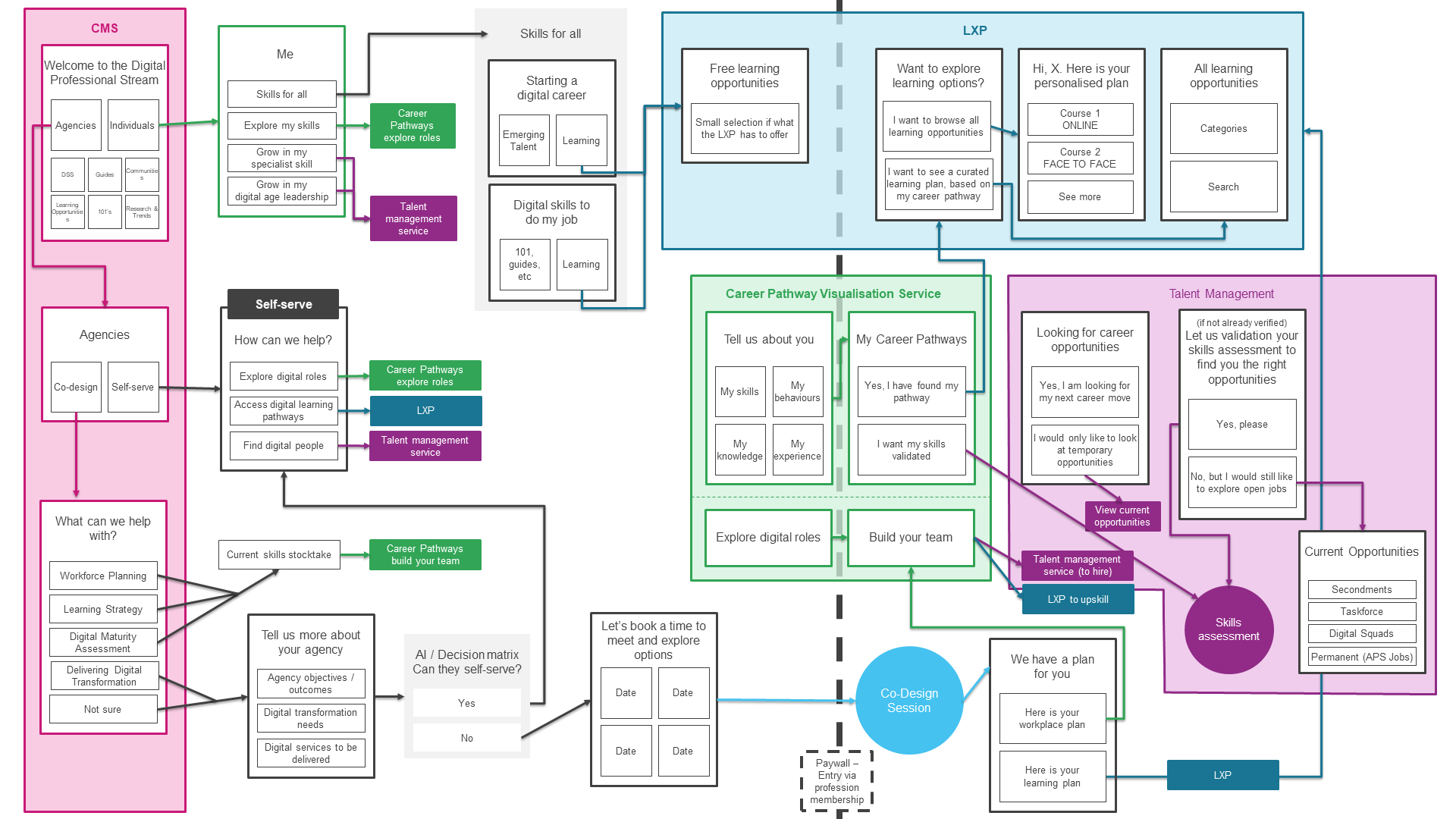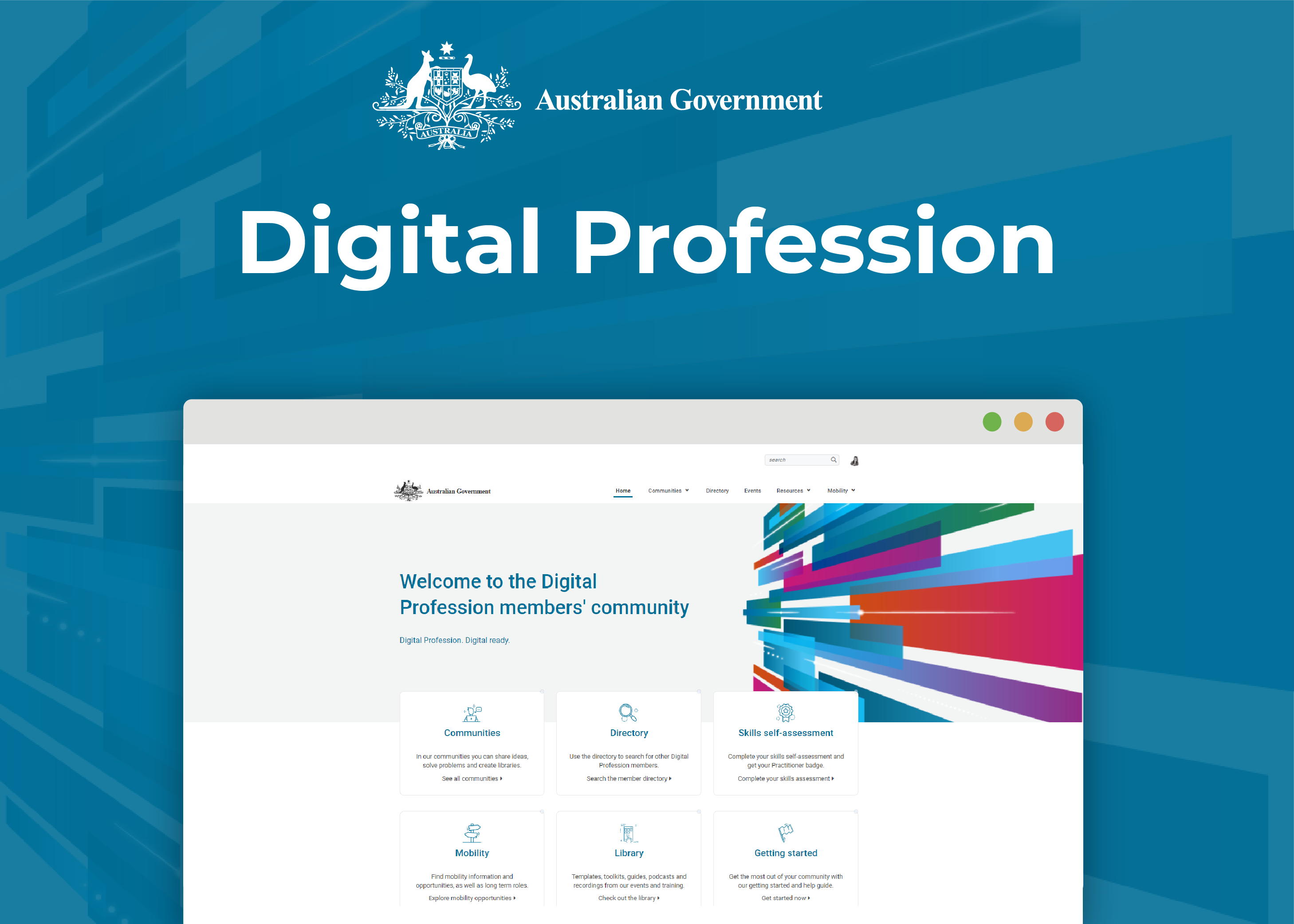Digital Profession
2020-2022
The Digital Profession was established through a recommendation from the APS Review (Thodey) to 'professionalise the Australian Public Service'. The Digital Profession team at the DTA approached this product using the Service Design and Delivery Process (SDDP) to uncover the user needs that sit behind this high level recommendation. I have worked in the small Digital Profession MDT since its inception and as such have had deep involvement in the discovery/research phase, as well as establishing and iterating our service offering.
Problem
"Will an 'APS Digital Profession' help to create a genuinely compelling offer that both attracts and retains talented digital and technology roles within the public sector?"
Digital and technology professionals are in high demand in all sectors, but especially in the public sector. Strong competition from private industry, particularly around remuneration, and the requirement for somewhat legacy skills and knowledge in the public sector, leaves us struggling to get, and keep, the capabilities we need. The intention of the Digital Profession is to prioritise the development and retention of this talent, through more than just salary.
Discovery: Gaining a deep understanding of the users and their needs, and developing hypotheses to solve the problems
3 workshops and 36 user research sessions on a broad range of topics from developmental programs and learning styles to platform ideation and testing. This user research was coupled with desktop research on professional associations, capability building in the 21st century and workplace culture. With support from the broader team, I planned and co-facilitated the 3 workshops, prepared the user research plans and facilitated some of the user research sessions. I also synthesised the data from these sessions to form assets including our customer journey map, service blueprint and ecosystem map as well as actionable insights for the broader team to respond to.



In this series of research sessions, we heard time and time again that our users often felt their skills were misunderstood; not recognised; and/or misused in their agencies. This frequently led to them having duties that were not suited to their skills, separation from their specialisation and below industry standard remuneration. These three issues became our guiding pain points, providing a strong evidential base for all the products and services under the Digital Profession banner. We also heard from this research that the priorities of our users were: professional standards; community; talent recognition and management; mobility; and foundational digital skills uplift. Our hypothesis was that these pain points and priorities could be addressed through the adoption of a common skills framework, supported by a community and career pathway data. To date we have shaped all our deliverables around the insights from this research.



Alpha: Developing, mapping and testing
My focus for the first 6 months of 2021 was to test the community aspect of our hypothesis. Our ambition for this product is that it will provide our users with a central place to record skills and continuing professional development activities, connect with other digital professionals and access events, training and guidance materials. Our point of differentiation from similar products offered by their employing agencies is that this record would follow them throughout their public service career. This community would accompany our Career Pathfinder product, which I worked on in 2020. Together they would bring a standardised skills framework (SFIA) into the mix to provide our users and their agencies clarity around roles and skills, in direct response to the pain points heard in our research.


Without access to a full time developer, we were limited to finding a customisable software as a service product. Using the insights from our user research and journey mapping, I researched and tested over a dozen potential products and services. During the process I also took it upon myself to learn basic front-end development skills to ensure our team had the skills required to implement the chosen product. Once selected, I spent time learning the product, creating more detailed journey maps and service blueprints that brought to life the steps our users would take, and everything they would encounter along the way. I identified steps that would need manual intervention in the short term, to ensure we were prepared for any administrative burden. I then mapped our entire service offering, to show our executive team how our products and services connected, and suggested ideas to improve this offering.


The [beta] solution
The beta pilot of the new Digital Profession offering, underpinned by the members community, launched in June and is so far meeting or exceeding all expectations of both key user groups, digital professionals in the APS and the agencies that employ them.
For APS digital professionals our solutions provide them with recognition as a Digital Practitioner via a profile that showcases their skills and a verifiable digital badge. They can build networks through access to communities of other practitioners, on member only forums. They receive priority and early access to professional development opportunities, events and networking as well as member only events. They can access short-term, flexible mobility opportunities to build skills and experience across the APS.
For agencies, we are providing value through the creation of a database that can be used to baseline skills of digital staff as well as digital roles across the APS. We are providing visibility and assurance of the digital practitioners they have and common language/framework to help them understand the skills those practitioners have. This then allows more structure in performance management conversations through a deeper understanding of digital roles and skills.
In the 12 months up to June 2021 we had 1500 members join, while in the last 2 months we have already had 700 new members join. I have been working closely with members of my team to continually iterate, test and develop this site as we move towards our live product.
You can visit the member community with the button below, however please note much of the functionality is exclusive to members and is not visible unless logged in.
